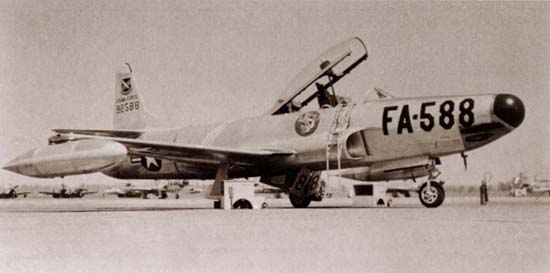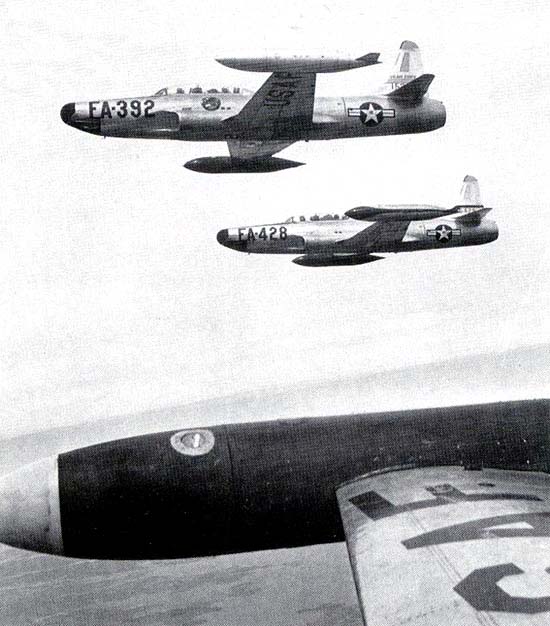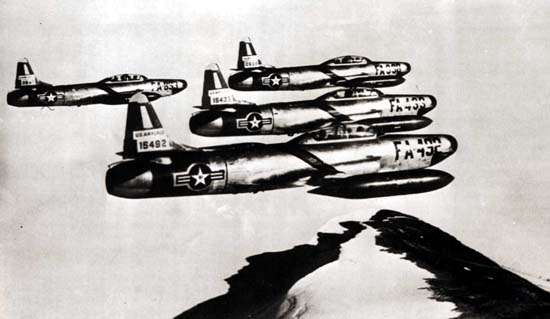|
|
|
THE F-94 ERA (1950 - 1954) |
|
|
 |
|
USAF |
|
Two eras of aviation history
on one ramp, P-82 Twin Mustangs can be seen in the background of
this picture of the first jet airplane flown by the 318th FIS, the F-94A
Starfire. Wearing 3 stripes to identify the aircraft as the squadron
commanders airplane, F-94A s/n 49-2588 was the last "A" model produced.
|
|
|
|
Starting with the 317th
Fighter Squadron in May of 1950, the 325th, Fighter Wing began to
replace its F-82's with the F-94A Starfire. In the fall of 1950, the
318th, ADC's last F-82 unit was also the last unit to enter the "jet
age" with its conversion into Lockheed F-94A Starfire, with some the
units F-82's move to join another Fighter unit in Alaska, while a few
would stay behind performing target towing duties until April 1951.
|
|
|
|
The F-94 Starfire, the
USAF's first first operational jet-powered
all-weather interceptor, and the first U.S. production jet equipped with
a afterburner, was developed from the
twin-seat T-33 "T-Bird" trainer, which was based on the single-seat F-80
Shooting Star, the first operational U.S. jet
fighter.
|
|
|
 |
|
USAF |
|
A 318th FIS F-94A leads
another F-94 from the 317th FIS. All F-94's were eventually refitted
with 230 gallon "Fletcher" centerline tip tanks.
|
|
|
|
On 1 May 1951, the
318th was redesignated as the 318th Fighter-Interceptor Squadron (318th
FIS). The 318th would later hold the "Fighter-Interceptor" moniker
longer than any squadron in the Air Force. In the Summer of 1951, the
318th along with the 317th and the Moses Lake based 319th FIS, deployed
to Edwards AFB in California aerial
gunnery
practice, this was the first deployment for a combat unit using radar
reflecting ranging systems towed by F-82's. While in Edwards, the
squadrons downed more than 80 targets and expended some 40,000 rounds of
ammunition during the record setting deployment.
|
|
|
|
On 9 October 1952, one
of the more devastating accidents involving the 318th occurred in the
squadrons F-94 era. During a routine training intercept, a 318th FIS
F-94 collided with a B-29 from the 5th Bombardment Wing, Travis AFB, CA
killing eleven on board of the bomber, the F-94 was able to return to
McChord.
|
|
|
|
The 318th fought
through a tough competition against its Divisional sister squadrons to
earn a spot in the ADC's first Aerial Gunnery
Meet, (forerunner to the William Tell Weapons Meet). Although the
squadron did not win the meet (which was won by the 354th FIS flying the
venerable North American F-51 Mustang), it was the beginning of a
impressive run for all fighter - interceptor squadrons attending nine of
the eighteen Air Defense Weapons Competitions, a feat not matched by any
other squadron in the Air Force.
|
|
|
 |
|
PICTURE FROM "LOCKHEED STARFIRE-A PHOTO CHRONICLE" BY MARTY J.
ISHAM & DAVID R. McCLAREN |
|
Moving from the mild Pacific
Northwest to the Arctic climates of Thule AB, Greenland, the 318th flew
the F-94B Starfire at the base for a little over one year.
|
|
|
|
In the middle
of 1953, the Green Dragons would begin a journey where they
would serve as the "tip" of the air defense "spear" against a
mass Soviet bomber raid with a move to
Thule
Air Base, Greenland replacing
an alert detachment from the 59th FIS consisting of a flight
of four F-94 aircraft. Thule, a base created to prevent another "Pearl Harbor", is
2752 miles from
Moscow, and 900 miles from the North
Pole. In preparation for their move to the frozen north, the
Squadron began a transition out of the F-94A and into the
F-94B, an upgraded version of the Starfire.
|
|
|
|
On 9 June
1953, the first of 3 flights of F-94's left McChord on a
10,000 mile trip to Thule AB, while other members of the
squadron, including maintenance personnel, traveled by rail to
New York where they would board a ship destined for Greenland.
No families were allowed to accompany squadron personnel on
their one-year rotation. The Green Dragons completed their
move from McChord and the Continental
Air Command (ConAC)
and officially aligned under the Northeast Air
Command on 20 June 1953.
|
|
|
|
Next page: The F-89 Era (1954 - 1955) |
|
|
|
|
 |